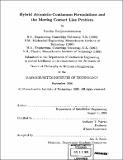Hybrid atomistic-continuum formulations and the moving contact line problem
Author(s)
Hadjiconstantinou, Nicolas G. (Nicholas George)
DownloadFull printable version (8.858Mb)
Advisor
Anthony T. Patera.
Terms of use
Metadata
Show full item recordAbstract
We present a formulation and numerical solution procedure for hybrid atomisticcontinuum representations of fluid flows. Hybrid representations are of great importance because they allow the solution of problems that require modelling on the microscale without the associated cost of a fully molecular solution. This is achieved by limiting the molecular treatment to the regions where it is needed while using the inexpensive continuum description in the remainder of the computational domain. The ingredients are, from the atomistic side, non-equilibrium molecular dynamics, and from the continuum side, spectral/finite element solutions. Molecular dynamics has been chosen for its ability to capture all the underlying physics without the need for modelling assumptions. The continuum solution techniques chosen represent the best compromise between the minimum computational cost, simplicity, and applicability to a wide variety of problems of interest. The matching is provided by a classical procedure, the Schwarz alternating method with overlapping subdomains. This matching technique exhibits favorable convergence properties and has been preferred because of its ability to bypass the problem of matching fluxes in molecular dynamics which has not been satisfactorily treated to date. Flow of a dense fluid (supercritical Argon) in a complex two-dimensional channel serves as a test problem for the validation of the technique developed above. Reasonable agreement is found between the hybrid solution and the fully continuum solution which is taken to be exact. The hybrid technique is subsequently applied to the moving contact line problem. The motion of contact lines (the locus of intersection of a two-fluid interface with a bounding solid) has, due to the multitude of length scales involved, been one of the few problems that has defied theoretical analysis over the years. It has long been concluded that continuum hydrodynamics is not adequate for the description of the physics involved in the vicinity of the contact angle, which is predominantly molecular kinetic, thus making this problem a good candidate for our solution technique. The basic ingredients for the hybrid treatment of the contact line problem are the continuum solution technique, the molecular solution technique, and a modified Schwarz method required due to the existence of two fluids and a two-fluid interface. The continuum solution is provided by a variationally consistent finite element simulation technique we have developed for the above reason. An already developed molecular simulation technique is adapted to provide the molecular solution. Our hybrid solution is compared with the fully molecular solution which serves as an exact solution for comparison purposes. Good agreement is found between the two solutions.
Description
Thesis (Ph.D.)--Massachusetts Institute of Technology, Dept. of Mechanical Engineering, 1998. Includes bibliographical references (leaves 149-153).
Date issued
1998Department
Massachusetts Institute of Technology. Department of Mechanical EngineeringPublisher
Massachusetts Institute of Technology
Keywords
Mechanical Engineering